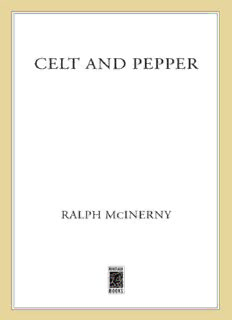
Celt abd Pepper PDF
Preview Celt abd Pepper
The author and publisher have provided this e-book to you for your personal use only. You may not make this e-book publicly available in any way. Copyright infringement is against the law. If you believe the copy of this e-book you are reading infringes on the author’s copyright, please notify the publisher at: us.macmillanusa.com/piracy. Contents Title Page Copyright Notice Dedication Epigraph Prologue Part One Chapter 1 Chapter 2 Chapter 3 Chapter 4 Chapter 5 Chapter 6 Chapter 7 Chapter 8 Chapter 9 Chapter 10 Chapter 11 Chapter 12 Chapter 13 Chapter 14 Chapter 15 Chapter 16 Chapter 17 Chapter 18 Chapter 19 Chapter 20 Part Two Chapter 1 Chapter 2 Chapter 3 Chapter 4 Chapter 5 Chapter 6 Chapter 7 Chapter 8 Chapter 9 Chapter 10 Chapter 11 Chapter 12 Chapter 13 Chapter 14 Chapter 15 Chapter 16 Chapter 17 Chapter 18 Chapter 19 Chapter 20 Epilogue Also by Ralph McInerny Copyright For Kevin and Helen Cawley Plots were seldom original: with fair frequency, there was the irrepressible, all-betraying sneeze in the dusty attic, or the pepper flung in the assailant’s eyes. —Shirley Hazzard, GREENE ON CAPRI PROLOGUE Winter is the season when the University of Notre Dame, now in the third millennium, most resembles its nineteenth-century origins. It was a bleak winter day in 1842 when Father Sorin arrived at the site of the future university and then as now a frigid wind came from the northwest and shook the leafless trees. Great drifts of snow descended from the log chapel to the frozen lake. Only a visionary could have seen a university rising from that snow-covered ground. There are countless more buildings now and for most of the year there is incessant activity on campus. While classes are in session ten thousand students reside in the dorms and other housing provided for them; they fill the dining halls and hurry from class to class along the campus walks. In May, after the graduation ceremonies are over, there is a slight lull, punctuated only by weddings in the campus church, but before the month is out a seemingly endless series of activities enlivens the campus. Flag-twirlers gather, crash courses in Catholicism are given, charismatic rallies are held, conferences convene, thousands of kids take part in sports programs, and wistful alumni wander about the campus, trying to get their bearings in the new Notre Dame. But winter is different. The midyear break runs from the second week in December to the third week in January, and the exodus from campus is almost total. The Morris Inn closes, the University Club shuts its doors, campus eateries keep irregular hours; the foreign student who has remained on campus, too far from home to go there, finds food difficult to get. The classrooms in DeBartolo and elsewhere are abandoned. In Decio and Molloy, the odd professor can be found in his office, but he is unlikely to answer a knock on his door. The thirteen floors of the library are all but deserted. North of the library, beyond the intervening quartet of residence halls, two towers rise, built originally to house students, but lately converted into offices. Grace accommodates the continuing metastasis of administrative activities, Flanner houses the University Press, a center or two, but largely faculty offices. Emeriti can be found there, moving arthritically about, but several floors are occupied by active faculty, by and large independent types who eschew Decio, attracted by this location, away from the center of things—eccentric, as one might say. A reclusive philosopher, experts in Dante, random members of Celtic Studies, are quartered there. It was in an office on the seventh floor of Flanner that the body of visiting professor Martin Kilmartin was discovered one January afternoon during the midsemester break. * “Don’t die between semesters,” Father Carmody advised Roger Knight. “Above all, don’t die in a campus office.” Prompted by the discovery of Kilmartin’s corpse, the old priest had been recounting lugubrious stories of campus deaths of yore, especially when the deceased had not been discovered for some time. In one such tale, Father McAvoy, the archivist, had been found in his office in the library on a Monday, having died most likely on the previous day. “That was quick,” Father Carmody added. “There have been some others…” He stopped when Roger lifted a hand. “Of course Joe Evans is a special case.” “Joe Evans?” “Director of the Jacques Maritain Center. A legendary bachelor don. But he lived off campus and was found dead in his apartment. In August. August is another bad month to die.” “What month would you recommend, Father?” “October,” Carmody said without hesitation. “Mid week in October. The funeral can be held on Saturday morning. A hundred thousand fans on campus!” Father Carmody was of an age, eighty on his last birthday, and doubtless found thoughts of death congenial enough. Often in talking with the old priest, Roger had the sense that Carmody felt somewhat posthumous already. But events like the discovery of young Kilmartin’s body revived him. “Did you know him, Roger?” “I had hoped to know him better. We really talked only once.” Roger shook his head. “There seemed no need for haste. I love his poetry.”
